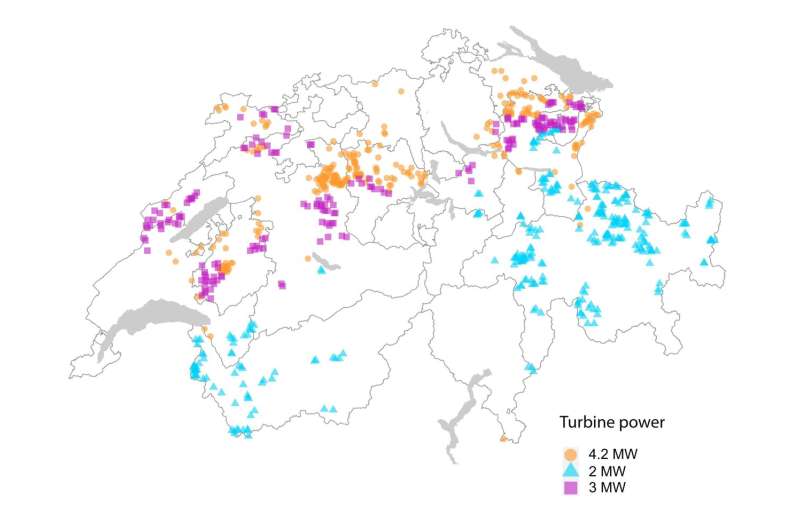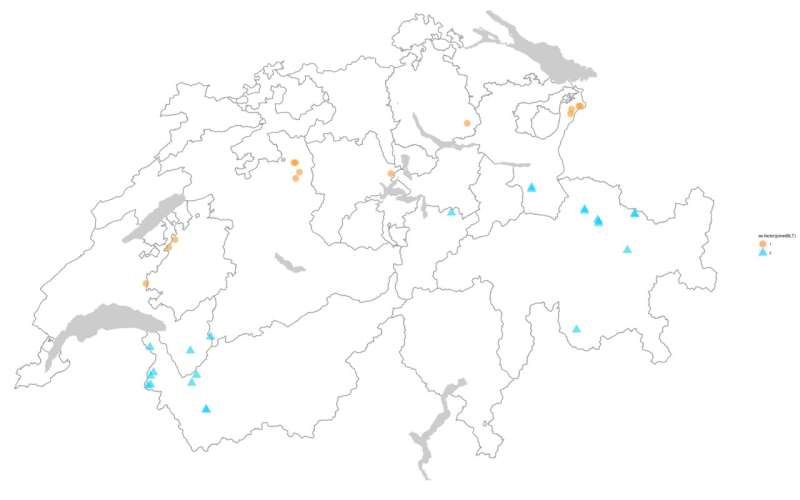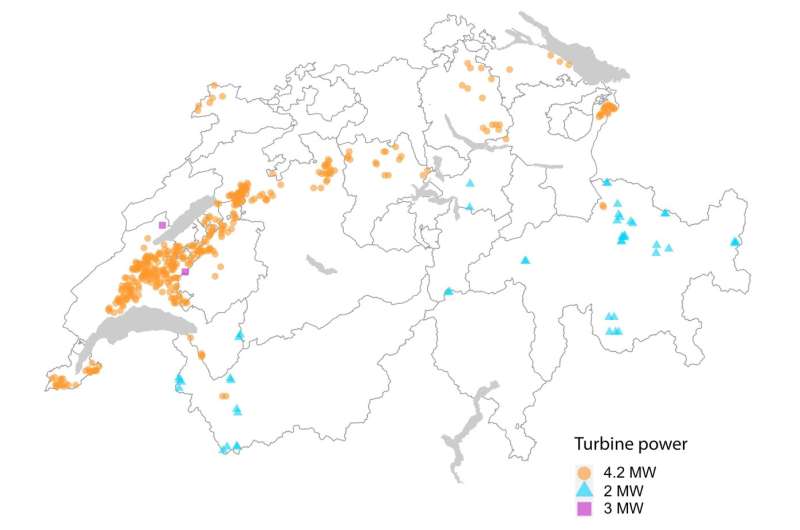Where should wind turbines be built in Switzerland?


Optimal distribution of wind power locations based on current wind energy concept. Orange circle: the largest wind turbine on the Swiss Plateau. Purple square: medium-sized turbine in the foothills of the Alps and the Jura Mountains. Turquoise triangle: smaller turbine in the Alps. Credit: Reto Spielhofer / ETH Zurich
A study by researchers at ETH Zurich shows for the first time how loosening Switzerland’s spatial planning policy will affect wind turbine locations. If the goal is to have as few wind turbines as possible in the Alps and in Switzerland in general, the use of windy agricultural areas in the Western Swiss Plateau should be considered.
By 2050, wind electricity is set to provide about 7% of Switzerland’s electricity. According to the Energy Strategy, this amounts to about 4.3 terawatt hours (TWh) per year. As of today, Switzerland is still a long way from achieving this goal: there are now almost 40 wind turbines produces only 0.14 TWh, or 0.3% of the energy.
Policymakers now want to accelerate energy production from wind energy. Especially in winter, when demand exceeds combined output from photovoltaic and hydroelectric plants, electricity from wind turbines will prevent shortages. But where is the best place to generate wind power in Switzerland? In the Alps, on the plains of the Swiss Plateau, or in the foothills of the Alps and in the Jura Mountains?
A study by ETH Zurich researchers led by Adrienne Grêt-Regamey, Professor of Landscape and Urban Systems Planning (PLUS), shows for the first time different scenarios for how the fringes are distributed- wind turbines by region to achieve the goal set out in the Swiss Energy Strategy 2050 as efficiently as possible. Article published in the magazine Environmental Science & Policy.
For the first time, the study’s authors also took into account windy areas turbine Construction is currently prohibited. “If we use particularly good agricultural land, known as crop rotation zones, on the windswept Swiss Plateau to generate wind power in addition to food production, then we do,” says Grêt-Regamey. we will have to build fewer wind turbines in the Alps.

A total of these 36 locations can only meet less than 5% of annual demand. Credit: Reto Spielhofer / ETH Zurich
Approximately 760 wind turbines in the reference scenario
The study authors’ reference scenario is based on the Swiss federal government’s wind energy concept, which identifies areas where wind energy can be harnessed. For example, it clearly states that wind turbines cannot be built in forests, on crop rotation areas or near heritage sites.
To generate 4.3 TWh of wind power per year in this scenario would require about 760 wind turbines. In their calculations, the researchers assumed that as few wind turbines as possible should be built in some particularly windy locations.
Since it is neither reasonable nor technically feasible to build the same turbine at all sites, the study considers smaller turbines (100 meters high, 39 meters rotor radius) for the mountain range. Alps, medium-sized turbines (125 meters high, 67 meters rotor radius) for the foothills of the Alps and Jura Mountains, and the largest and most powerful wind turbines (150 meters high, 73 meters blade radius) ) for the plains of the Swiss Plateau. The following should be noted: at full power, a large turbine on the plains of the Swiss Plateau generates twice as much power as a small turbine in the Alps.
Substantial development needed in the Alps
Of the approximately 760 wind turbines needed, about 40% will be located in Grison and the Pennine Alps. But about 300 of these small turbines will only generate about 20% of annual output. “This is not optimal, as the construction and operating costs of wind turbines in the mountains tend to be higher than in the plains, and the Swiss see the idea of wind turbines in the landscape. The unspoiled natural landscape in the Alps is particularly worrisome,” explains Grêt-Regamey.
About half of the 4.3 TWh will be generated by about 260 of the largest turbines on the plains of the Swiss Plateau—80% of which will be in the cantons of Bern, St. Gallen, Lucerne and Friborg. The remaining 30% of wind energy expected annually until 2050 will be served by about 180 turbines in the foothills of the Alps, most of which are located in the cantons of Bern, Friborg, St. Gallen and Appenzell Ausserrhoden.
Based on these calculations, the researchers created a map showing the approximate distribution of wind turbines. “Spots should be considered as national focal areas, not exact locations for them,” said Reto Spielhofer, lead author of the study and a researcher in the Grêt-Regamey research group. wind turbines.
As part of the reference scenario, the researchers also identified 36 sites that are particularly suitable for wind energy generation. Without the need to adjust spatial planning policies, these sites together could meet just under 5% of annual demand. Nine of these sites are located in the cantons of Graubünden and Valais, six in St. Gallen, five in Bern, two in Vaud and Fribourg, and one in the canton of Uri.

Crop rotation areas: If crop rotation areas are allowed to be used for wind turbines, the largest concentration of wind turbines (orange circles) on the western windswept plateau Switzerland would be optimal. This means fewer smaller turbines (turquoise triangles) will be needed in the Alps. Credit: Reto Spielhofer / ETH Zurich
Less than 300 turbines with crop rotation areas
The study by ETH Zurich researchers also examined the effect of the relaxation of spatial planning requirements on the distribution of wind turbines in the region. For example, in one scenario, they assumed that crop rotation areas could also be used for wind energy. “We know that such use of the land is extremely controversial, as it is very good farmland, producing high agricultural productivity,” says Grêt-Regamey.
However, the researchers wanted to show what the extent of wind energy expansion would be if the turbines could also be placed in areas of crop rotation, especially those where winds blow frequently. piercing and strong. Compared to the reference scenario, approximately 300 fewer wind turbines across Switzerland would be needed to generate the expected wind power is 4.3 TWh per year.
Strong focus on the western Swiss plateau
“If we relax the spatial planning regulations as they relate to crop rotation areas, we would need almost 200 fewer wind turbines in Grison and the Pennine Alps,” says Grêt-Regamey. compared to the reference scenario.
Just over 3% of the annual target of 4.3 TWh of wind energy would have to be generated in the Alps and less than 1% in the foothills of the Alps and the Jura Mountains. Meanwhile, more than 96% will come from the largest turbines on the plains—and especially the western Swiss plateau. Of the approximately 460 wind turbines in this scenario, just over 40% will be located in the canton of Vaud and about 13% each in the cantons of Friborg and Bern.
“There is a trade-off between the number of wind turbines and their distribution,” says Gret-Regamey, “If we want to have as few wind turbines as possible—both in general and in the Alps. in particular—we have to build large structures, wind turbines are clearly visible where the wind is the most: on the western Swiss Plateau On the other hand, if we prioritize protecting areas crop rotation, then we won’t be able to avoid an expansion in the Alps.”
More information:
Reto Spielhofer et al., How Spatial Policies Can Accelerate the Energy Transition − Finding Pareto optimal solutions for wind turbine sites with evolutionary multi-objective optimization, Environmental Science & Policy (2023). DOI: 10.1016/j.envsci.2023.02.016
quote: Where should wind turbines be built in Switzerland? (2023, March 20) get March 20, 2023 from https://techxplore.com/news/2023-03-turbines-switzerland.html
This document is the subject for the collection of authors. Other than any fair dealing for private learning or research purposes, no part may be reproduced without written permission. The content provided is for informational purposes only.




